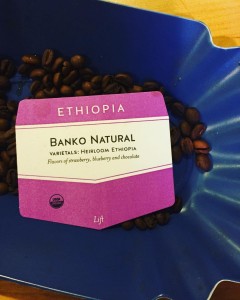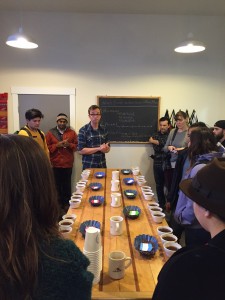Evergreen student sampling an espresso blend at a tasting at Olympia Coffee Roasting Company. Photo taken by Willow-Creek Feighery
During our field study at Olympia Coffee Roasting Company and our interview with Sam Shoeder, we were enlightened on the various waves coffee has gone through in the past seventy years, and where OCR falls into the game. The three waves of coffee are so named “first wave”, “second wave”, and “third wave”, the latter being where OCR places themselves in this classification style. Below is the synopsis of each wave of coffee:
1: “Folgers, and your commercially produced coffee . . . where it’s really focused on prices, so price being the motivator . . . going to sell you a lot of coffee for really cheap
2: The beginning of espresso culture and specialty coffee in the United States, Pete’s, Starbucks, focused on crafting you a co
ffee, usually with a darker roast. Making blends, a direct contrast to Folger’s, 1970s to the 1990s.
3: Began around 2003, Olympia Coffee Roasting Company began in 2005. Doing direct trade, paying above Fair Trade standards. Main concern is quality of coffee, and bringing out unique flavor of beans, experimenting with wash processes. Coffee is the product, not a confection using coffee beans.
Coffee going new wave (third wave):
Starbucks is opening “Starbucks Reserve” roastery in Seattle to compete with high quality roasteries. This is good for businesses like OCR because it introduces people to a higher quality of coffee, and to the flavor of coffee, specialty coffees. Starbucks Reserve does not compete with small, quality roasteries because the coffee that the higher quality roastery will produce won’t actually be very delectable.
Folger’s to high quality coffee is a hard sell. However, Starbucks to high quality coffees is an easier tradition as they are very similar in price with great discrepancies in flavor.




